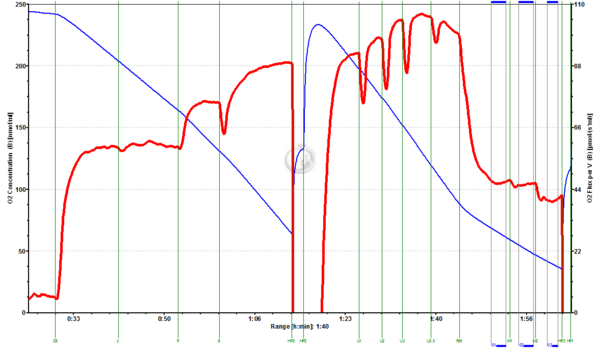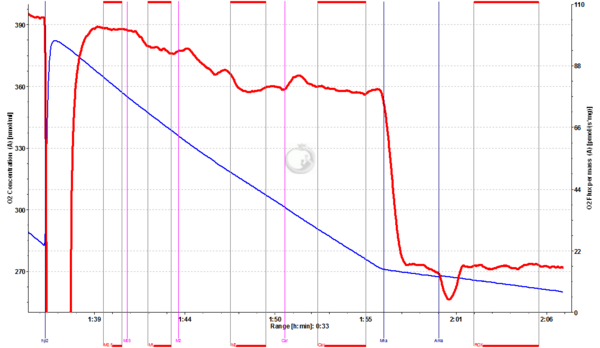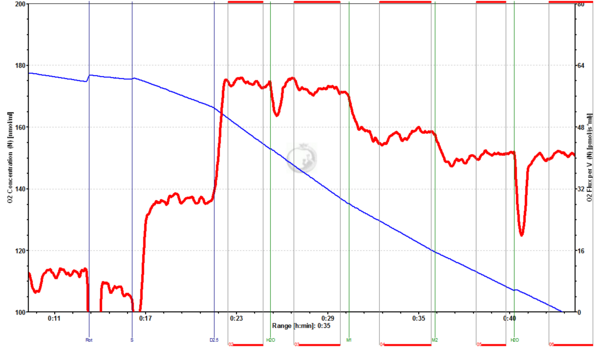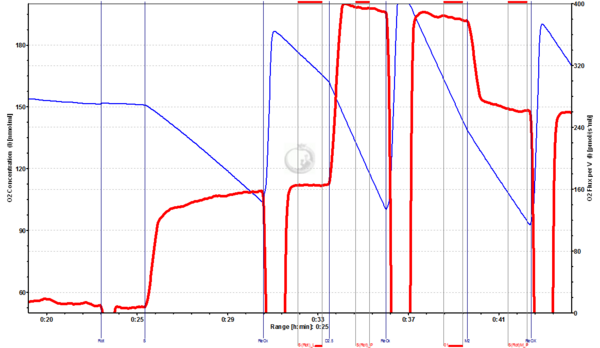Difference between revisions of "Talk:Malate"
| (9 intermediate revisions by 4 users not shown) | |||
| Line 1: | Line 1: | ||
[[Image:BB-Bioblast.jpg|left|40px|link=Bioblast:About|Bioblast wiki]] | |||
== Popular Bioblast page == | |||
::: [[Malate]] has been accessed more than | |||
::::* 15,000 times (2019-12-12) | |||
::::* 10,000 times (2017-10-12) | |||
::::* 5,000 times (2015-03-02) | |||
== Optimum malate concentration in SUIT protocols == | == Optimum malate concentration in SUIT protocols == | ||
: '''A MiPNet publication | : '''A MiPNet publication in preparation by Sumbalova Z, Krumschnabel G, Schöpf B, Burtscher J, Fontana-Ayoub M, Laner V, Kotb IA, Salin K, Hand SC, Ali SS, Gnaiger E et al.''' | ||
: [http://www.bioblast.at/index.php/Sumbalova_2016a_Abstract_MitoFit_Science_Camp_2016 Sumbalova_2016a_Abstract_MitoFit_Science_Camp_2016] | |||
The type and concentration of respiratory substrates is important for the design of substrate-uncoupler-inhibitor titration (SUIT) protocols. | The type and concentration of respiratory substrates is important for the design of substrate-uncoupler-inhibitor titration (SUIT) protocols. | ||
0.5 mM malate saturates CI linked respiration in combination with pyruvate and/or glutamate, whereas 2 mM malate inhibits CII linked (succinate | 0.5 mM malate saturates CI-linked respiration in combination with pyruvate and/or glutamate, whereas 2 mM malate inhibits CII-linked (succinate,rotenone) and CI&II-linked respiration, as shown in mouse heart (collaboration with the group of [[EG Cairo Ali SS|Sameh Ali]]), mouse brain homogenate, beef heart mitochondria, human permeabilized skeletal muscle fibres, dog permeabilized skeletal muscle fibers ([http://www.oroboros.at/?IOC84_Alaska IOC84]), brine shrimp embryo (''Artemia franciscana'') mitochondria (collaboration with [[US LA Baton Rouge Hand SC|Steve Hand]]), fish liver and heart homogenates ([http://www.oroboros.at/?IOC80_schroecken#c3877| post IOC80 training course]). | ||
Some representative examples are presented here. | Some representative examples are presented here. | ||
'''Arctic | '''Arctic charr liver homogenate''' | ||
[[Image:Char liver homogenate Malate effect.png|600px]] | [[Image:Char liver homogenate Malate effect.png|600px]] | ||
Fig.1. Arctic | Fig. 1. Arctic charr liver homogenate (3.99 mg/ml, 15 °C): GM0.5+D5+c+P+S+reox+U1+U2+U3+U3.5+Rot+M1+M2. Liver homogenate respiring at CII linked ETS were given 1 mM and 2 mM malate (M1 and M2), which inhibited respiration by 1.1% and 13%, respectively. Experiments post IOC80; data evaluation by [[Salin K|Karine Salin]]. | ||
'''Arctic | '''Arctic charr heart homogenate''' | ||
[[Image:Char heart homogenate Malate effect.png|600px]] | [[Image:Char heart homogenate Malate effect.png|600px]] | ||
Fig.2. Arctic | Fig. 2. Arctic charr heart homogenate (1.05 mg/ml, 15 °C): G+M0.5+D5+c+P+S+reox+U1+U2+U3+U3.5+Rot(not shown)]+M1+M2+Car+Mna+Ama. Heart homogenate respiring at CII-linked ETS was given 1 mM and 2 mM malate (M1 and M2), which inhibited respiration by 7% and 15%, respectively. Adding carrier (Car) inhibited only 0.9%. Experiments post IOC80; data evaluation by [[Salin K|Karine Salin]]. | ||
'''Mouse brain homogenate | '''Mouse brain homogenate''' | ||
[[Image:Mouse brain homogenate Malate effect.png|600px]] | [[Image:Mouse brain homogenate Malate effect.png|600px]] | ||
Fig.3. Mouse brain homogenate (0.9 mg/ml): Rot+S+D2.5+Car1+M1+M2+Car2. Addition of the carrier water (Car1, Car2) had no significant impact on CII | Fig. 3. Mouse brain homogenate (0.9 mg/ml): Rot+S+D2.5+Car1+M1+M2+Car2. Addition of the carrier water (Car1, Car2) had no significant impact on CII linked OXPHOS (inhibition by 2.2% and -0.2%), whereas the addition of 1 mM and 2 mM Malate (M1 and M2) inhibited respiration by 21% and 11%, respectively. Experiment in the OROBOROS MitoLab and data evaluation by [[Kotb IA]]. | ||
'''Beef heart mitochondria | '''Beef heart mitochondria''' | ||
[[Image:Beef heart Mitochondria Malate effect.png|600px]] | [[Image:Beef heart Mitochondria Malate effect.png|600px]] | ||
Fig.4. Beef heart mitochondria: Rot+S+D2.5+M2. Beef heat mitochondria respiring at CII | Fig. 4. Beef heart mitochondria: Rot+S+D2.5+M2. Beef heat mitochondria respiring at CII linked OXPHOS were given 2 mM malate (M2), which inhibited respiration by 31%. Experiment in the OROBOROS MitoLab by Heidler et al. | ||
'''Brine shrimp embryo mitochondria | '''Brine shrimp embryo mitochondria''' | ||
[[Image:Brine shrimp embryo mitochondria Malate effect.png|600px]] | [[Image:Brine shrimp embryo mitochondria Malate effect.png|600px]] | ||
Fig.5. Brine shrimp embryo mitochondria: | Fig. 5. Brine shrimp embryo mitochondria: Rot+S+D2.5+cyt c+ U+M0.5 (not shown)+M2+Ama. Brine shrimp embryo mitochondria respiring at CII linked ETS with 0.5 mM Malate were given 2 mM malate (M2), which inhibited respiration by 12%. Experiment in the OROBOROS MitoLab by [[US_LA_Baton_Rouge_Hand_SC|Steve Hand]] et al. | ||
Latest revision as of 15:20, 12 December 2019
Popular Bioblast page
- Malate has been accessed more than
- 15,000 times (2019-12-12)
- 10,000 times (2017-10-12)
- 5,000 times (2015-03-02)
- Malate has been accessed more than
Optimum malate concentration in SUIT protocols
- A MiPNet publication in preparation by Sumbalova Z, Krumschnabel G, Schöpf B, Burtscher J, Fontana-Ayoub M, Laner V, Kotb IA, Salin K, Hand SC, Ali SS, Gnaiger E et al.
- Sumbalova_2016a_Abstract_MitoFit_Science_Camp_2016
The type and concentration of respiratory substrates is important for the design of substrate-uncoupler-inhibitor titration (SUIT) protocols.
0.5 mM malate saturates CI-linked respiration in combination with pyruvate and/or glutamate, whereas 2 mM malate inhibits CII-linked (succinate,rotenone) and CI&II-linked respiration, as shown in mouse heart (collaboration with the group of Sameh Ali), mouse brain homogenate, beef heart mitochondria, human permeabilized skeletal muscle fibres, dog permeabilized skeletal muscle fibers (IOC84), brine shrimp embryo (Artemia franciscana) mitochondria (collaboration with Steve Hand), fish liver and heart homogenates (post IOC80 training course).
Some representative examples are presented here.
Arctic charr liver homogenate
Fig. 1. Arctic charr liver homogenate (3.99 mg/ml, 15 °C): GM0.5+D5+c+P+S+reox+U1+U2+U3+U3.5+Rot+M1+M2. Liver homogenate respiring at CII linked ETS were given 1 mM and 2 mM malate (M1 and M2), which inhibited respiration by 1.1% and 13%, respectively. Experiments post IOC80; data evaluation by Karine Salin.
Arctic charr heart homogenate
Fig. 2. Arctic charr heart homogenate (1.05 mg/ml, 15 °C): G+M0.5+D5+c+P+S+reox+U1+U2+U3+U3.5+Rot(not shown)]+M1+M2+Car+Mna+Ama. Heart homogenate respiring at CII-linked ETS was given 1 mM and 2 mM malate (M1 and M2), which inhibited respiration by 7% and 15%, respectively. Adding carrier (Car) inhibited only 0.9%. Experiments post IOC80; data evaluation by Karine Salin.
Mouse brain homogenate
Fig. 3. Mouse brain homogenate (0.9 mg/ml): Rot+S+D2.5+Car1+M1+M2+Car2. Addition of the carrier water (Car1, Car2) had no significant impact on CII linked OXPHOS (inhibition by 2.2% and -0.2%), whereas the addition of 1 mM and 2 mM Malate (M1 and M2) inhibited respiration by 21% and 11%, respectively. Experiment in the OROBOROS MitoLab and data evaluation by Kotb IA.
Beef heart mitochondria
Fig. 4. Beef heart mitochondria: Rot+S+D2.5+M2. Beef heat mitochondria respiring at CII linked OXPHOS were given 2 mM malate (M2), which inhibited respiration by 31%. Experiment in the OROBOROS MitoLab by Heidler et al.
Brine shrimp embryo mitochondria
Fig. 5. Brine shrimp embryo mitochondria: Rot+S+D2.5+cyt c+ U+M0.5 (not shown)+M2+Ama. Brine shrimp embryo mitochondria respiring at CII linked ETS with 0.5 mM Malate were given 2 mM malate (M2), which inhibited respiration by 12%. Experiment in the OROBOROS MitoLab by Steve Hand et al.




